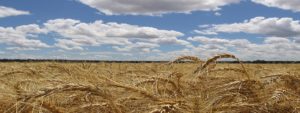GRDC initiative
GRDC Strategic Research Initiative: Future Farm – Improving Farmer Confidence in Targeted N Management Through Automated Sensing and Decision Support

About the Future Farm Program
The Future farm program is focusing on the challenges of increasing grain industry profitability and safety by optimising the use of inputs, enabling new farming practices and the automation of routine processes. As part of the analysis, the grains sector has identified that further improvement in nitrogen use efficiency is required to optimise within-field crop canopy, yield and quality management.
Optimising the efficient use of nitrogen (N) fertiliser is an important goal for cereal growers across Australia. It typically represents 30-40% of input costs and is a major determinant of both profitability and productivity; GRDC’s More Profit from Crop Nutrition (MPCN) initiative shows farmer risk is closely related to the magnitude and effectiveness of expenditure on N fertiliser. One way of optimising N use is to use the tools of Precision Agriculture (PA) to deliver on the 4 Rs – putting the right amount of the right product in the right place at the right time. However, such strategies can require a substantial investment in time spent processing and analysing data, may require several steps that are not necessarily well integrated, while farmer confidence in these tools as decision aids is low given some of the assumptions which underpin them. The opportunity therefore exists to re-examine and improve the way in which soil and crop sensors are used to inform decisions about N management and to provide a way of automating the process from data acquisition, through analysis, to the formulation and implementation of decision options. The Future Farm Program is targeted to address these issues using a nationwide network of well monitored on-farm fertiliser response trials.
While nitrogen application decision support tools are already available, their operation is not necessarily optimal and the identification and utilisation of information from a range of new data streams will greatly improve the spatial and temporal resolution of the application decisions. By including the use of in-season field monitored data in the decision process it should be possible to adaptively generate optimal site-specific nitrogen application models relevant to the time of application. The automation of these decision rules in software and the linkage to real-time application equipment will bring access to this substantial improvement in nitrogen application decision-making to cereal grain and cotton growers across Australia.
The Project brings together USYD, CSIRO, USQ, QUT and Agriculture Victoria Research with the aim of delivering to growers, a tool which they can have confidence in as the basis for improved and less risky N fertiliser decision-making.
This research is being conducted collaboratively with growers from each of GRDC’s grain growing regions. The Phase 1 review was completed in January 2018, and Phase 2 is now engaged with on-farm, commercial scale fertiliser trials, in-season soil and crop monitoring, data analysis and model development underway.
More information is available on the GRDC website. GRDC Update Wagga Wagga 2020 ; GRDC Update Adelaide 2020
An evolving video series discussing some of the findings can be found HERE

